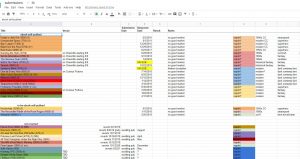Submissions Tetris Part 3: Reprints
So far, I’ve talked about submission trackers and planning submissions. This week, I’m talking about reprint submissions.
Most of my inspiration for selling reprints came from two posts I read some years back by Deborah Walker, who is a prolifically published author who makes the most of her reprint rights. You can read those posts about selling reprints and finding markets for reprints.
The nice thing about reprints is that the story is done. Once the rights have reverted to you, there’s virtually no reason to NOT try to have that story reprinted as many times as possible. After all, you were theoretically paid well for its first printing. Why shouldn’t you keep it in a position to bring you more income?
Reprint markets are not necessarily as well paying as first rights markets. They might only buy you a coffee or a fast food meal. But that isn’t always the case. I have one story that was printed, then reprinted, then podcast, and then reprinted again. While the first reprint market paid very little, the podcast paid five times what my first publication did, and my second reprint of that story paid almost three times what the podcast paid. Your mileage will almost definitely vary on this–this is pretty much the opposite of what happens to most stories!

So how do I use my spreadsheet to track reprints? The image above is a little on the blurry side, but it’s divided into three sections. The top block is reprint stories that I have also self-published. Most of these stories have been to nearly all of the reprint markets that they’re appropriate to–the exception is the two that have yellow highlighting on their row, which means they’re currently on submission. But even for the stories that aren’t out at the moment, I keep notes on them, so if a new market looking for reprints pops up, I have a robust list of stories that might fit the bill.

Also blurry, but it shows you the information I track about reprints–genre and/or setting, spread over a couple of columns. Color coding has to do with the collections they were in or will be in.
The second batch (the smallest of the three sections) is for stories that are reprints that I’m planning to self-publish. But I prefer to do themes for my self-published collections, which means that these are stories that are waiting for some more stories with a similar theme to come back to me. And these, too, might go out if the perfect market pops up.
The third section is for stories where the rights haven’t reverted to me yet (some of these aren’t even published yet). I keep track of these, along with the date when they come back to me, so that as soon as their initial period of exclusivity ends, I can start sending those out to reprint markets. This is the main meat of my reprint submissions most of the time.
I also have another section below these, which is for my themed collections that are getting close to ready to self-publish. In general, those reprints are not in regular circulation, because I don’t want to tie any of them up (thus delaying a collection). But if I spot a perfect market for one of them, I weigh whether another reprint of that story prior to the collection would be good or bad, and then go from there.
I’ve got one more post about my submissions tetris, which quite possibly explains how I have so many stories in circulation at any given time (aside from the fact that I write a lot). Simultaneous submissions, complete with some tips and tricks on that sticky subject! Tune in next week to learn more!

Comments